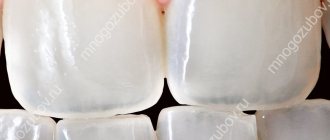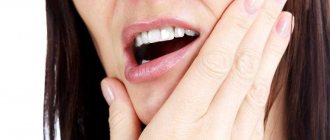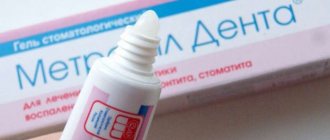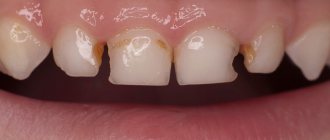Teeth perform not only chewing and speech functions, but also aesthetic ones. When communicating with a person, we always pay attention to his smile, which often subconsciously determines our attitude towards the interlocutor. However, not everyone is naturally blessed with straight, white teeth. Dull tooth enamel with a yellowish or other tint is the most common complaint that dentists encounter, according to reviews. Finding the reason why teeth are yellow is not always easy. After all, the color of teeth is influenced not only by external factors, but also by internal ones.
In this article, we will introduce you to the main reasons why teeth are yellow, show photos and reviews of patients with yellow teeth, and also tell you what the treatment is and what methods of teeth whitening exist.
Why teeth become yellow, causes of yellowness
There are many reasons why teeth become yellow. And they are not always hidden in poor oral hygiene or bad habits. Often, in search of the reason why teeth become yellow, doctors resort not only to a dental examination, but also to additional laboratory and instrumental research methods before treatment.
So, what are the most common causes of yellow teeth? The reasons why teeth become yellow may be as follows:
- Genetic predisposition - in most cases, yellow teeth are inherited. If the parents have a pronounced yellowness of the enamel, then it is possible that the child’s teeth will also be yellow during eruption (photo on the right).
- Bad habits, smoking in particular - such a problem as yellow teeth is familiar to every smoker. Teeth do not change their color immediately, but gradually - this process is individual and can take several years.
- Coloring drinks and food. Coffee, tea, wine, colored carbonated drinks, carrots, beets - regular consumption of all this can cause yellow teeth.
- The reasons often lie in medications - antibiotics of the tetracycline group and antiseptic drugs can negatively affect the color of teeth.
- Occupational hazards - working with acid vapors (hydrochloric, nitric, sulfuric and other acids).
- Poor oral hygiene, or its complete absence.
- Regular consumption of water with high iron content.
- Injuries.
- Dental pathology - it can cause yellowness of all or only some teeth. If a nerve is damaged, for example, only the diseased tooth becomes dull (photo on the right).
- Somatic pathology (fluorosis, adrenal and kidney failure, endocrine and nervous diseases).
- Age-related changes.
“Handy” options for combating yellow teeth
There are many home whitening methods to lighten the shade of tooth enamel. However, before you try another method on yourself, you should consult a specialist on this issue. Below we have provided some effective tips to help make your smile snow-white:
- You need to firmly give up drinking red wine, coffee, tea and smoking.
- Natural natural whitening agents include fresh basil, lemon juice, apples and sage leaves.
- Once a week, you are allowed to add a little baking soda to the toothpaste (this is a rather aggressive abrasive substance, so you should never overuse it).
- It is better to drink any sweet drinks through a straw so that the liquid cannot leave characteristic marks on the enamel.
- Eating solid natural foods in their raw form helps to naturally cleanse the outer layer of enamel.
If you have a problem similar to that described in this article, be sure to contact our specialists. Don't diagnose yourself!
Why you should call us now:
- We will answer all your questions in 3 minutes
- Free consultation
- The average work experience of doctors is 12 years
- Convenient location of clinics
Single contact phone number: +7
Make an appointment
What do yellow teeth look like in a photo?
If you have no idea what yellow teeth look like, see the photo below. In some patients, yellowness is characteristic of only some teeth, while in others, all yellow teeth can be seen without exception. The photos below also demonstrate the different localization of yellowness - in some it evenly covers the entire tooth, while in others it is localized only on some part of it. The uneven yellow color of the enamel, as can be seen in the photo, is observed when taking tetracycline antibiotics, as well as when smoking (a more yellow color is observed in the cervical areas due to the presence of stones).
Below there is a photo of what yellow teeth look like, photos of the teeth of children and adults.
Charge for regular drinks
It would seem that there is nothing reprehensible in a cup of coffee or tea in the morning, afternoon and evening. Most people have long been accustomed to these liquids, although they appeared in our culture, frankly speaking, relatively recently. One way or another, getting too carried away with them can also lead to yellow teeth. By the way, the type and color of tea does not really matter here. For example, the majority today do not even know how to choose the right green tea, opting for advertised, unnatural varieties with an abundance of artificial coloring substances. Suffice it to say that the popular so-called “milk oolong” is a chemical that the Chinese themselves will never drink.
Yellow teeth: what to do and how to whiten yellow teeth
Almost all owners of yellow, dull enamel are interested in how to whiten yellow teeth. Some resort to traditional medicine methods, others to various chemical whitening procedures. However, it should be remembered that before you whiten yellow teeth, you need to find the cause of this problem.
If external factors (smoking, consumption of coloring drinks and foods, occupational hazards) have caused a problem such as yellow teeth, what to do is absolutely clear!
First of all, you need to remove the provoking factor - without this, no treatment will save your yellow teeth. What to do if there are internal reasons? If these are somatic or dental diseases, their treatment comes first.
Rules for children's dental hygiene
The first oral hygiene procedures begin after the baby has cut his first tooth. During this period, the brush is not yet used, and the gums are wiped with a damp cloth. When several teeth erupt, you can begin hygiene with the help of a special baby brush. It should be very soft and delicately clean the delicate surface of children's teeth. When a child reaches 2.5 years of age, he is taught to practice brushing independently, at first without toothpaste. When the baby masters this procedure, you can use special baby pastes, which are designed for the fact that the baby has not yet learned to spit out the paste and will periodically swallow it. Children's pastes should be free of dyes, flavorings and fragrances.
Treatment of yellow teeth, patient reviews
It should be remembered that yellowness can also be a symptom of some pathology. Therefore, the treatment of yellow teeth should be comprehensive and carried out only after the cause of yellowness has been established. Reviews from patients also note that treatment of yellow teeth can be successful only if provoking factors are excluded and all rules of oral hygiene are strictly observed. In addition to treatment, it would be advisable to use whitening toothpastes, powders, and gels.
Clinical researches
Multiple clinical studies have proven the effectiveness of Asept products. For example, as part of the tests, it was found that the two-component mouth rinse ASEPTA ACTIVE more effectively combats the causes of inflammation and bleeding compared to single-component rinses - it reduces inflammation by 41% and reduces bleeding gums by 43%.
Clinical studies have also proven that regular use of professional toothpaste ASEPTA REMINERALIZATION improved the condition of the enamel by 64% and reduced tooth sensitivity by 66% after just 4 weeks.
Clinical studies have proven that regular use of preventive toothpaste ASEPTA SENSITIVE for a month can reduce bleeding gums by 62%, reduce the sensitivity of teeth and gums by 48% and reduce inflammation by 66%.
Sources:
- Report on determining/confirming the preventive properties of toothpaste “ASEPTA PLUS” GENTLE WHITENING” Author: doctor-researcher A.A. Leontyev, head Department of Preventive Dentistry, Doctor of Medical Sciences, Professor S.B. Ulitovsky First St. Petersburg State Medical University named after. acad. I.P. Pavlova, Department of Preventive Dentistry
- Clinical and laboratory assessment of the influence of domestic therapeutic and prophylactic toothpaste based on plant extracts on the condition of the oral cavity in patients with simple marginal gingivitis. Doctor of Medical Sciences, Professor Elovikova T.M.1, Candidate of Chemical Sciences, Associate Professor Ermishina E.Yu. 2, Doctor of Technical Sciences Associate Professor Belokonova N.A. 2 Department of Therapeutic Dentistry USMU1, Department of General Chemistry USMU2
- Report on the determination/confirmation of the preventive properties of personal oral hygiene products “ASEPTA PLUS” Remineralization doctor-researcher A.A. Leontyev, head Department of Preventive Dentistry, Doctor of Medical Sciences, Professor S.B. Ulitovsky First St. Petersburg State Medical University named after. acad. I.P. Pavlova, Department of Preventive Dentistry
- Clinical studies of antisensitive toothpaste “Asepta Sensitive” (A.A. Leontyev, O.V. Kalinina, S.B. Ulitovsky) A.A. LEONTIEV, dentist O.V. KALININA, dentist S.B. ULITOVSKY, Doctor of Medical Sciences, Prof. Department of Therapeutic Dentistry, St. Petersburg State Medical University named after. acad. I.P. Pavlova
- The role of anti-inflammatory rinse in the treatment of periodontal diseases (L.Yu. Orekhova, A.A. Leontyev, S.B. Ulitovsky) L.Yu. OREKHOVA, Doctor of Medical Sciences, Prof., Head of Department; A.A. LEONTIEV, dentist; S.B. ULITOVSKY, Doctor of Medical Sciences, Prof. Department of Therapeutic Dentistry of St. Petersburg State Medical University named after. acad. I. P. Pavlova
- Report on determining/confirming the preventive properties of toothpaste “ASEPTA PLUS” COFFEE and TOBACCO Author: doctor-researcher A.A. Leontyev, head Department of Preventive Dentistry, Doctor of Medical Sciences, Professor S.B. Ulitovsky. First St. Petersburg State Medical University named after. acad. I.P. Pavlova, Department of Preventive Dentistry
- Report on determining/confirming the preventive properties of commercially produced personal oral hygiene products: Asepta toothpaste used in combination with Asepta mouthwash and Asepta gum balm Head. Department of PFS Doctor of Medical Sciences Professor S.B. Ulitovsky St. Petersburg State Medical University named after Academician I.P. Pavlova. Faculty of Dentistry. Department of Preventive Dentistry.
Methods to combat plaque
At the initial stage, soft deposits can be easily removed with a regular toothbrush. Experts also recommend using special rinses, pastes containing useful minerals and additives to strengthen the enamel. If you neglect the recommendations of specialists and forget to brush your teeth, the plaque can become hard. Then it will be much more difficult to deal with him.
Professional cleaning at a dental clinic will help remove stone and other deposits. The examination may also reveal the following pathologies: caries, stomatitis, periodontitis, gingivitis, etc. They will need to be treated first.
An equally popular procedure is enamel whitening. Today there are many methods; the appropriate option should be selected based on the results of a preliminary examination and the clinical picture of a particular patient. Most methods are based on the action of hydrogen peroxide, which, by interacting with a catalyst, breaks down plaque and returns the smile to its former attractiveness. It is important to note that bleaching allows you to lighten enamel up to 14 tones in one session, and professional cleaning only returns the enamel to its original shade.
previous post
Why install dentures where there are no teeth?
next entry
Why is plaque on teeth dangerous?
Don't underestimate the plaque that accumulates on the surface of our teeth every day. It is not as harmless as it might seem at first glance. Over time, plaque can cause the development of serious pathologies, such as periodontitis. This disease affects the condition of the gum tissue and can appear against the background of already progressing gingivitis. If left untreated, the disease can lead to the loss of one or more teeth.
The plaque quickly turns into hard deposits - stone. These deposits contain small particles of food, bacteria, and calcium compounds of epithelial cells. This is no longer just an aesthetic defect, but a serious problem leading to active damage to the enamel by caries.
This pathological process is characterized by targeted demineralization of the hard tissues of the tooth, as a result of which they gradually darken and die. In this case, a cavity appears in the dentin structure, which grows over time and can even affect the root of the tooth. This pathology is difficult to treat, patients often experience relapses, and in 40% of people the situation becomes chronic.
Yellow plaque in children over 7 years old
Deposits discovered during school age are most often associated with improper tooth brushing procedures. It is important that a suitable brush is selected taking into account the level of sensitivity of the gum tissue. Special care is not required when performing routine procedures systematically. True, if the situation is seriously advanced, then you cannot do without a visit to the dentist. When a child is 8 years old or older, teeth cleaning using the Air Flow method is prescribed, if necessary. This procedure is safe and painless.
A harbinger of pathology is bad breath and a slippery coating on the crowns and gums. A timely cleaning procedure will prevent the mineralization of soft plaque, which often happens at this age. Refined and soft carbohydrate foods should be limited. Such products get clogged into the interdental spaces. It is useful to give children solid vegetables and fruits, for example, carrots or apples. Remember that proper hygiene is the key to oral health and the best remedy against yellow discolouration!
Special diet
It is believed that apples and raw carrots are the best teeth cleaners. These products perfectly remove plaque and supply a huge amount of useful substances to the body. Therefore, you should not limit yourself to them.
The LeaderStom network of clinics offers the services of the best pediatric dentists in Moscow. If you seek professional help in time, the condition of your child’s teeth can be correctly corrected with a course of treatment or preventive measures. Experienced therapists and orthopedists will help eliminate pathological yellowness of teeth and straighten your baby’s bite if indicated. Contact us, we are always ready to help.
Recommendations from Dr. Zubastik
A snow-white smile is attractive and fashionable. If your teeth have acquired a yellowish tint, try one of the suggested remedies. As a doctor, I still recommend pharmacy methods, not home recipes. And don’t forget about the main condition: before whitening, make sure that the oral cavity is sanitized.
And now, as is tradition, video tips on how to overcome yellow teeth. Let's see?
Tags: activated carbon, Vodka, Gel, Yellow teeth, Yellow plaque, Mouth guards, strawberries, lemon, folk remedies, Whitening strips, hydrogen peroxide, soda, Table vinegar, Sage
About the author: Dr. Zubastik
Typically, a toothache begins to subside on the way to the clinic and finally goes away after 10 minutes of sitting in line to see the dentist.
- Related Posts
- A child’s baby tooth has fallen out: what to do?
- What to do if your teeth hurt after whitening
- Tooth hurts after extraction: what to do?
« Previous entry










